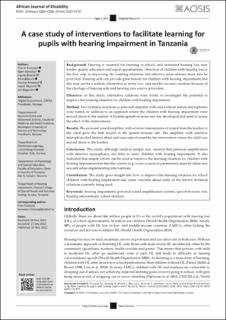| dc.contributor.author | Tronstad, Tron Vedul | |
| dc.contributor.author | Gjessing, Bjørn | |
| dc.contributor.author | Ørland, Ingvild | |
| dc.contributor.author | Øderud, Tone | |
| dc.contributor.author | Mnyanyi, Cosmas B. F. | |
| dc.contributor.author | Myovela, Isaack | |
| dc.contributor.author | Øygarden, Jon | |
| dc.date.accessioned | 2023-03-02T14:27:57Z | |
| dc.date.available | 2023-03-02T14:27:57Z | |
| dc.date.created | 2022-11-17T09:21:43Z | |
| dc.date.issued | 2022 | |
| dc.identifier.citation | African Journal of Disability. 2022, 11, a974. | en_US |
| dc.identifier.issn | 2223-9170 | |
| dc.identifier.uri | https://hdl.handle.net/11250/3055484 | |
| dc.description.abstract | Background: Hearing is essential for learning in school, and untreated hearing loss may hinder quality education and equal opportunities. Detection of children with hearing loss is the first step in improving the learning situation, but effective interventions must also be provided. Hearing aids can provide great benefit for children with hearing impairment, but this may not be a realistic alternative in many low- and middle-income countries because of the shortage of hearing aids and hearing care service providers.
Objective: In this study, alternative solutions were tested to investigate the potential to improve the learning situation for children with hearing impairment.
Method: Two technical solutions (a personal amplifier with and without remote microphone) were tested, in addition to an approach where the children with hearing impairment were moved closer to the teacher. A Swahili speech-in-noise test was developed and used to assess the effect of the interventions.
Results: The personal sound amplifier with wireless transmission of sound from the teacher to the child gave the best results in the speech-in-noise test. The amplifier with directive microphone had limited effect and was outperformed by the intervention where the child was moved closer to the teacher.
Conclusion: This study, although small in sample size, showed that personal amplification with directive microphones did little to assist children with hearing impairment. It also indicated that simple actions can be used to improve the learning situation for children with hearing impairment but that the context (e.g. room acoustical parameters) must be taken into account when implementing interventions.
Contribution: The study gives insight into how to improve the learning situation for school children with hearing impairment and raises concerns about some of the known technical solutions currently being used. | en_US |
| dc.language.iso | eng | en_US |
| dc.publisher | AOSIS Publishing | en_US |
| dc.rights | Navngivelse 4.0 Internasjonal | * |
| dc.rights.uri | http://creativecommons.org/licenses/by/4.0/deed.no | * |
| dc.title | A case study of interventions to facilitate learning for pupils with hearing impairment in Tanzania | en_US |
| dc.title.alternative | A case study of interventions to facilitate learning for pupils with hearing impairment in Tanzania | en_US |
| dc.type | Peer reviewed | en_US |
| dc.type | Journal article | en_US |
| dc.description.version | publishedVersion | en_US |
| dc.rights.holder | © 2022 The Authors. | en_US |
| dc.source.volume | 11 | en_US |
| dc.source.journal | African Journal of Disability | en_US |
| dc.identifier.doi | 10.4102/ajod.v11i0.974 | |
| dc.identifier.cristin | 2075283 | |
| dc.relation.project | Norges forskningsråd: 267527 | en_US |
| dc.relation.project | Norges forskningsråd: 316345 | en_US |
| dc.source.articlenumber | a974 | en_US |
| cristin.ispublished | true | |
| cristin.fulltext | original | |
| cristin.qualitycode | 1 | |

